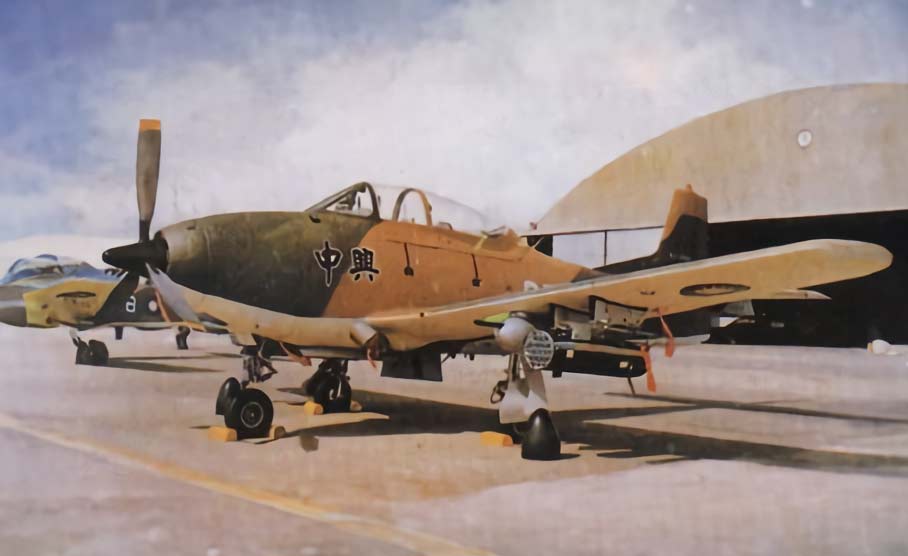The AIDC T-CH-1 is a Taiwanese advanced trainer aircraft, designed for effective pilot training and light attack missions.
In brief
The AIDC T-CH-1 Chung-Hsing, developed by Aerospace Industrial Development Corporation, is Taiwan’s venture into creating an advanced trainer aircraft with light attack capabilities. This propeller-driven plane, characterized by its single-engine and tandem seating, aimed to fulfill the training requirements of the Republic of China Air Force (ROCAF). With its first flight in the 1970s, it represented a significant stride in Taiwan’s aviation industry, providing an indigenous solution to military training needs. Equipped with basic avionics, it offered a practical platform for pilot training, while its hardpoints enabled light attack roles, illustrating versatility in its design.
The AIDC T-CH-1 (Chung-Hsing) trainer aircraft
The AIDC T-CH-1 Chung-Hsing’s journey begins against the backdrop of the Cold War era, a time when Taiwan sought to bolster its defense capabilities amidst regional tensions. Recognizing the importance of a self-reliant defense industry, Taiwan aimed to reduce its dependence on foreign military equipment. The T-CH-1 project was launched by the Aerospace Industrial Development Corporation (AIDC) in the early 1970s, under the impetus of developing an indigenous trainer aircraft that could also perform light attack missions.
The development of the T-CH-1 was driven by the need for an advanced training aircraft to prepare pilots for the transition to more sophisticated jet fighters in the ROCAF’s arsenal. On its maiden flight in 1973, the T-CH-1 marked a significant milestone in Taiwan’s aviation industry, demonstrating the capabilities of the country’s emerging aerospace development program.
Design of the AIDC T-CH-1 (Chung-Hsing)
The design of the T-CH-1 Chung-Hsing reflects its dual role as a trainer and light attack aircraft. Its airframe features a conventional layout with a low-wing configuration, providing stability and maneuverability required for training purposes. The aircraft is powered by a single piston engine, driving a three-bladed propeller, a choice that balances performance with cost-effectiveness for a training platform.
In terms of dimensions, the T-CH-1 spans a length of 29 feet (8.84 meters) and a wingspan of 33 feet (10.06 meters). This compact size facilitates ease of handling for trainee pilots. The cockpit is arranged in a tandem seating configuration, with the instructor seated behind the student, a layout conducive to effective training.
One of the design advantages of the T-CH-1 is its adaptability to various training scenarios, from basic flight training to more advanced combat tactics. However, the reliance on a piston engine, while economical, limits its speed and altitude capabilities compared to jet-powered trainers. Despite this, the T-CH-1 brought significant value to the ROCAF by providing a cost-effective, indigenous solution for pilot training.

Performance of the AIDC T-CH-1 (Chung-Hsing)
The performance characteristics of the T-CH-1 are tailored to its role as a training aircraft. Powered by a Lycoming engine, it delivers adequate power for its training missions, with a maximum speed of around 270 miles per hour (435 kilometers per hour) and a service ceiling of 25,000 feet (7,620 meters). Its range of 1,000 miles (1,609 kilometers) ensures sufficient endurance for extended training sessions.
When compared to contemporary trainers of its time, such as the Beechcraft T-34 Mentor or the Cessna T-37 Tweet, the T-CH-1 offered a balance between performance and operational cost, making it a viable option for countries with limited defense budgets. Its performance metrics, while not groundbreaking, provided a solid foundation for pilot training programs.
Variants of the AIDC T-CH-1 (Chung-Hsing)
The T-CH-1 program saw the development of several variants, each tailored to specific training or light attack roles. The primary version was the standard trainer model, designed for basic and advanced pilot training. Subsequent variants included modified versions with enhanced avionics for improved navigation and targeting training, showcasing the platform’s versatility.
Military Use and Combat of the AIDC T-CH-1 (Chung-Hsing)
The T-CH-1 was primarily used by the ROCAF for pilot training, preparing aviators for transition to more advanced aircraft. Its armament capabilities, including provisions for bombs and rockets, also allowed for light attack training missions, providing a realistic combat training environment.
While the T-CH-1 was not extensively used in combat operations, its role in training combat-ready pilots was invaluable. The aircraft’s deployment within Taiwan’s defense framework underscored its significance in enhancing the operational readiness of the ROCAF. The T-CH-1 competed with other trainer aircraft of the era but held its ground due to its dual-role capability and cost-effectiveness.
To date, the T-CH-1 has been succeeded by more modern training aircraft, reflecting advancements in technology and training methodologies. Its retirement marked the end of an era for Taiwan’s indigenous trainer development but left a legacy of contributing significantly to the country’s defense capabilities.
–
The AIDC T-CH-1 Chung-Hsing stands as a notable achievement in Taiwan’s aviation history, serving as a cornerstone for pilot training within the ROCAF. Its development and operational use highlight Taiwan’s commitment to building a self-reliant defense capability. While technology has advanced beyond the capabilities of the T-CH-1, its contribution to training competent pilots for Taiwan’s defense needs is an enduring legacy of this versatile aircraft.
Back to the Trainers section.